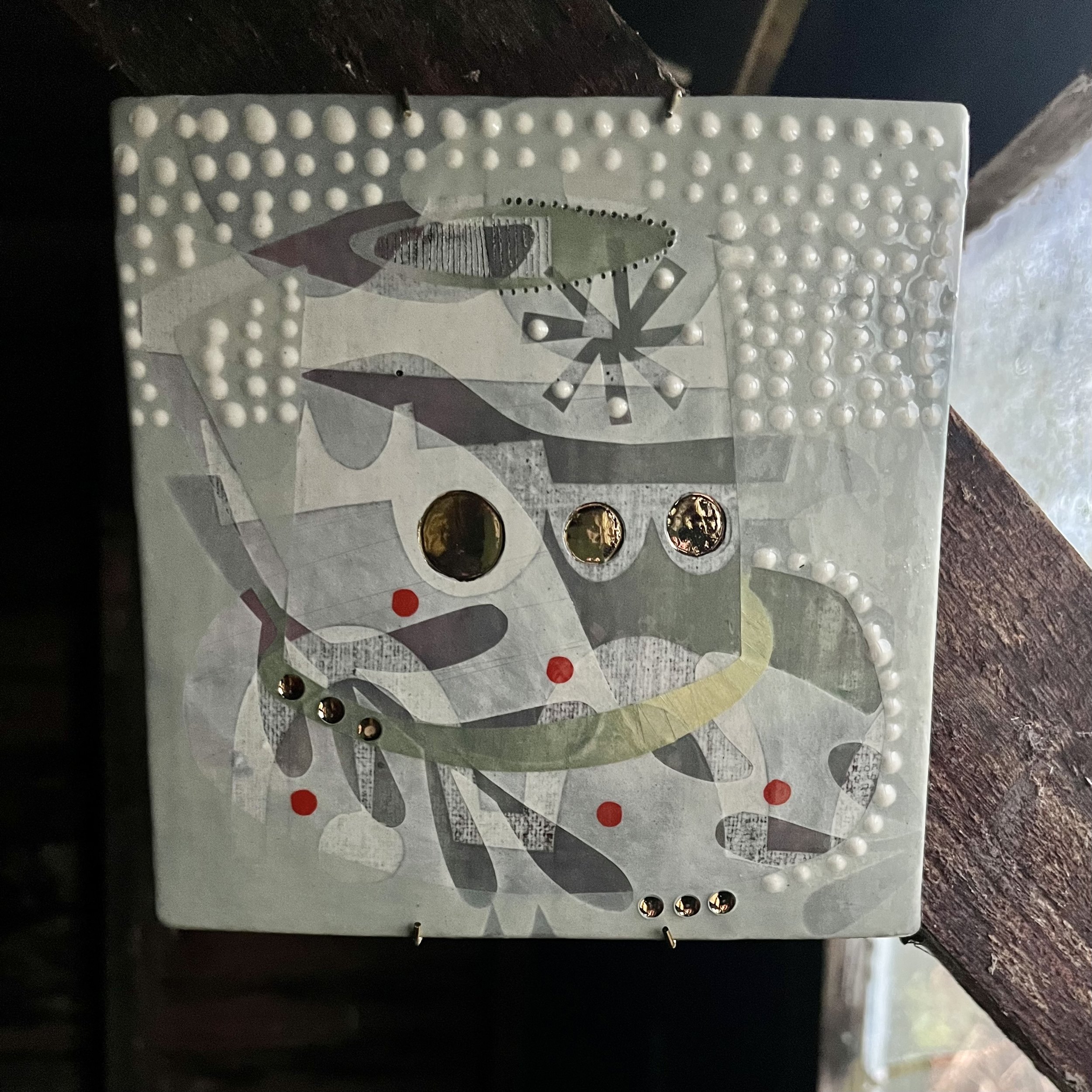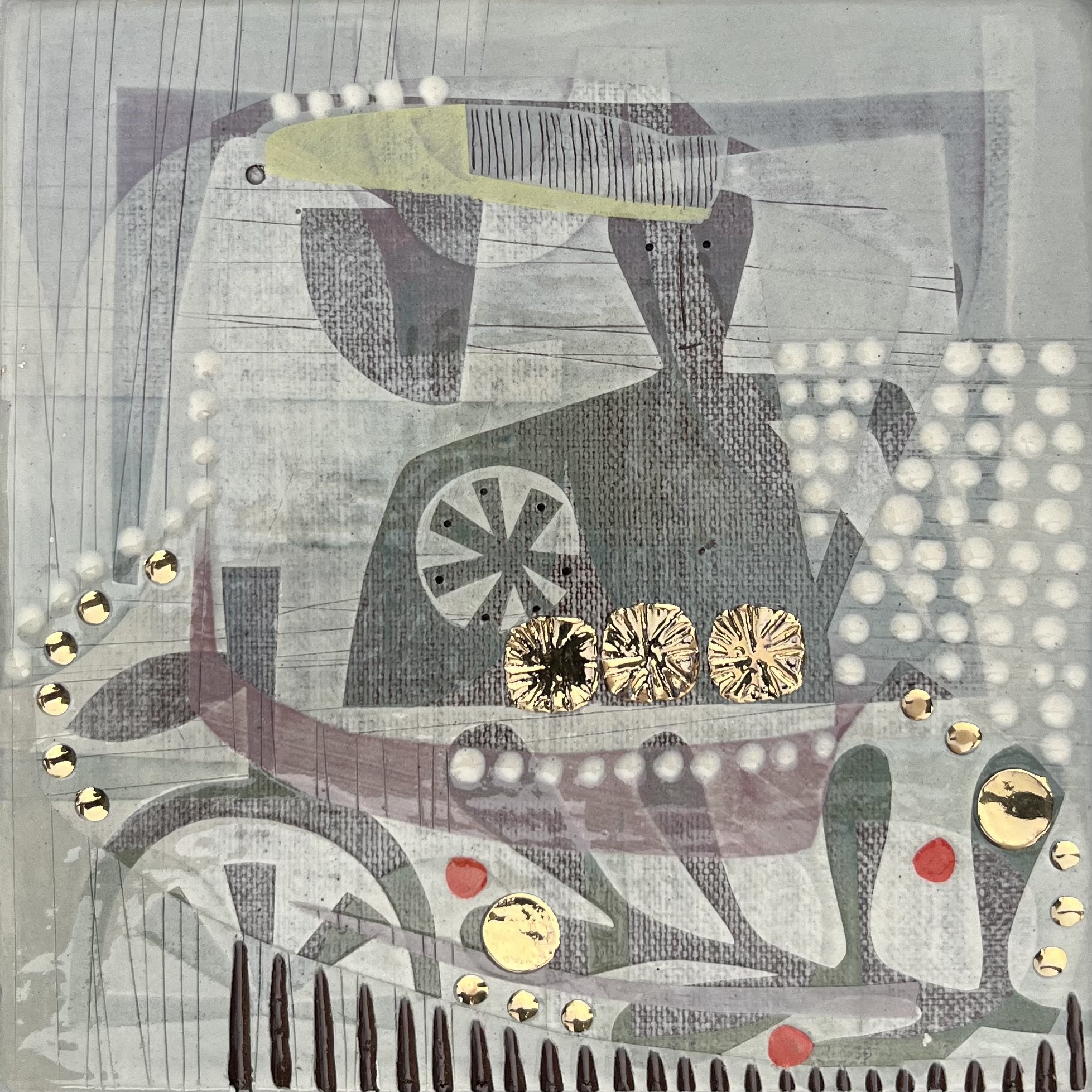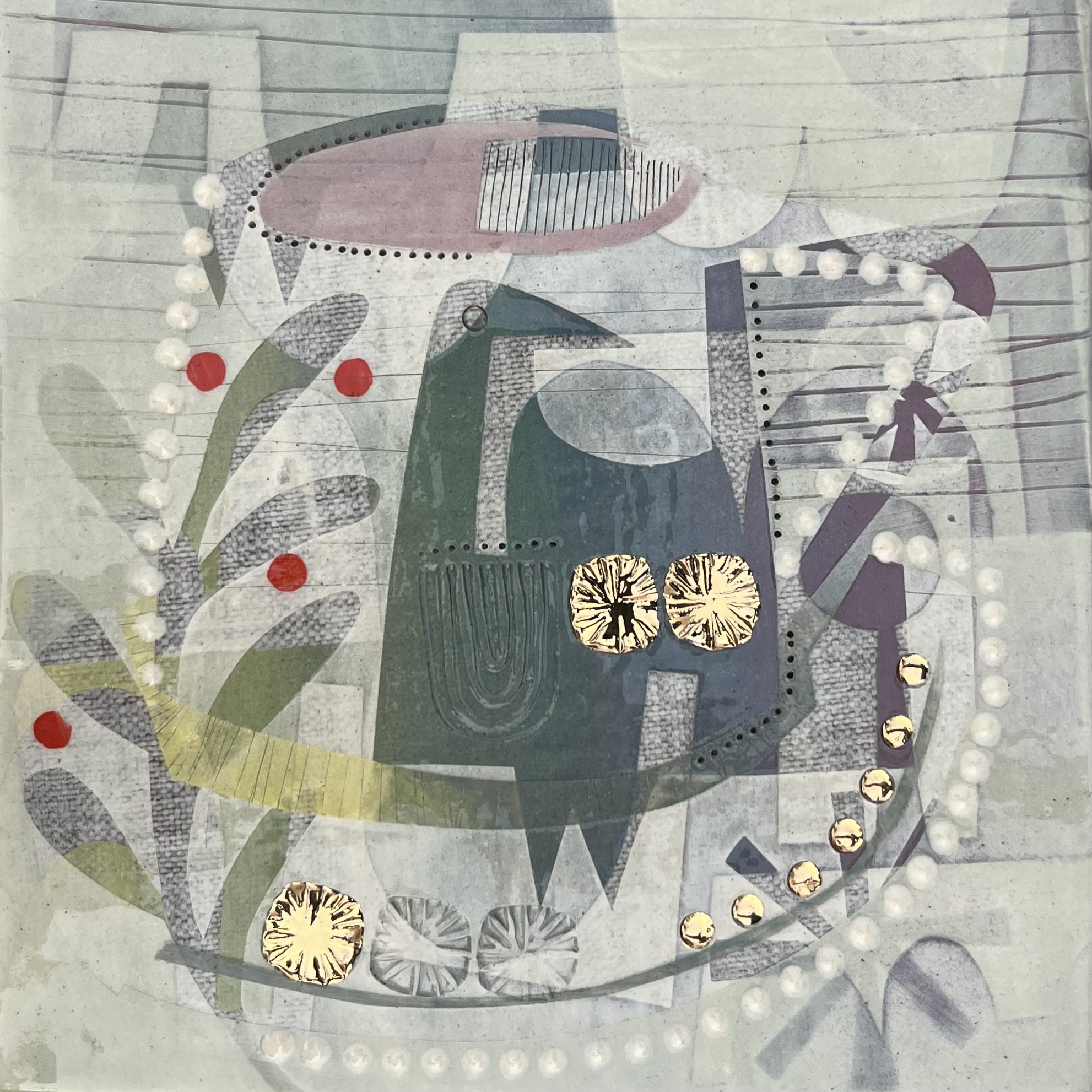Story Tiles
There is something satisfying about the surface of glazed tiles. Like reflections on water the glazed surface flickers as it catches light, creating a dreamlike quality. ‘Story Tiles’ are ceramic ‘paintings’ which celebrate the directness of clay. They can be propped up on a shelf, lie flat on a table or hang on a wall, they are objects in themselves, similar to beach stones or shells.
Paper cut stencils are used to build layers of images and create depth through an application of coloured slip. The ‘shadows’ of masked shapes are still visible as imprints. Each Story Tile represents a fleeting memory of birds, plants, people, and boats. The final layer of a ‘cup and saucer’ image is barely discernible but represents the object that holds the ‘story’, similar to a theatre stage ‘framing’ a play. Old china can be a poignant combination of the precious and the intimate, with touches of gold lustre and intricate decoration, chipped with years of use.
While making these tiles I imagined finding them in a old wooden hut, in woodland, near my studio. China is very often the last surviving sign of habitation. Stories and memories reflected in the lustre of glaze.
Wee Ladies
At Drey Workshop we take pride in making pieces for homes, however living and working in close proximity to the beautiful wild nature of Argyll, I have a yearning for our work to be ‘discovered’ within the landscape. Two summers ago I took part in an archeological dig at Tarbert castle on Loch Fyne, and the process of uncovering fragments of past lives was addictive, medieval clay jug handles with the potter’s thumb prints clearly visible, buttons, coins, iron tools eroded until almost unrecognisable, and of course, victorian pottery shards often with plant inspired patterns.
Museums all over the world have beautiful examples of small prehistoric clay ‘venus’ figures. These depict archetypical simplified female forms often with exaggerated features. I decided to make our earthenware ‘wee ladies’ and decorate them with shapes inspired by the Tarbert dig. These are small, only 12cm high and I imagine them ideally being ‘found’ in woods. Perhaps a small spot of gold lustre glinting in the dappled sunlight catching the eye of a observant woodland walker.
Of course treasure in the woods is hard to come by and I think the ladies would be just as happy living near your house plants!
Skylines
The Scottish poet Kathleen Jamie writes in her essay ‘Skylines’, in her book ‘Findings’
“maybe I don’t look upward enough.”
The latest Drey Workshop jar designs are inspired by the numerous statues, globes, cupids and cockerels which populate the city skyline. In particular the wind vanes which she discovers tend to
“belong to buildings which are less high and less grand”
In the bustling distractions of a modern city the celebration of wind direction is perhaps a humbling reminder of the natural world. Our eldest son, Cavan, lives in a flat in Glasgow’s city centre. He looks directly onto a beautiful slightly crumbling Victorian red sandstone building with an ornate wind vane on its roof. The wrought ironwork silhouetted against the Campsie hills, pale in the distance, is a gentle reminder of the wider world beyond. An invitation to travel on the wind North, East, South and West.
Here is one of our North South East West Jars being decorated.
Bird Jars
The strange situation of ‘lockdown’ reduced our focus to the very local. For us at Drey Workshop in rural Argyll this meant a increased awareness wildlife and in particular the birds. The cluster of trees outside our windows became a light dappled world that captivated us. We convinced ourselves we could actually see the trees grow! We hung a bird feeder from a low branch and it became so popular we began to worry we were upsetting the natural equilibrium of the natural woodland. We decided to withdraw our peanuts and then instantly felt guilty. Interacting with nature was obviously a complex business!
Lacking our normal contact with family and friends we started to discuss, for what seems now ridiculously long periods, the social behaviours of the birds. Our running commentary didn’t stop at analysing their distinctive characters but also their changing plumage.
Thank goodness ‘lockdown’ has ended but our new found respect for our bird companions has inspired our latest batch of jars. Our designs are not species specific but a distillation of personalities, colours and patterns. We hope you like them!
Motifs
This past week I have been decorating new jars and considering what it is that makes a design feel finished. Looking through old sketchbooks I realise certain forms and subjects reoccur. I suspect that it is this evolving language of ‘motifs’ that makes the decorating process feel like a visual narrative that, at a certain point, suddenly seems complete.
The wheels of a tiny golden Greek chariot, seen in the British Museum, become a segmented circle. West coast rain bands of vertical lines scratched into slip. Architectural arches and dome shaped shelters enclose smaller shapes. Leaves, birds and figures merge on sea worn pebble forms. A semicircle moon. Jewel-like rowan berries, spots of bright colour.
Visiting Uist in the Outer Hebrides last year I saw a beautiful Eriskay Garnsey jumper with a form of pattern which felt familiar. These jumpers were originally made for the seafaring men of the island communities from a lovely tight twist 5-ply, oiled yarn. The effect of the raised pattern in this tight yarn is like a carved relief. The skill involved in memorising the stitch designs before the advent of paper instructions is awe inspiring.
Each jumper would be a unique combination of evolving traditional motifs arranged for maximum geometric effect and personal relevance.
The Tree of life, Pennant flag, Horseshoe, Harbour steps, Flying geese, Marriage lines, Anchor, Starfish and Wave.
To the knitter and wearer the jumper would read like a visual narrative of Hebridean life. The garment would be complete when all the chosen motifs were included in a satisfying symmetry. As a non-knitter the complexity of knitting patterns fills me with dread but to an Eriskay knitter the craft was an intuitive, flexible communication in a familiar language.
For more information about Eriskay designs: https://www.facebook.com/KnitEriskay/
Gold
This week we did a gold lustre firing in the workshop. Our earthenware clay and slip applied decoration is a far cry from the fine porcelain china tea cups of our grandparents, with their delicate floral designs and golden flourishes.
Reading Kit Williams’ book Masquerade, as an 11 year old, I realised it was not the riddle clues or beautiful intricate paintings that interested me but the physical gold hare treasure, photographed on the end cover, lying on earth, amongst decaying leaves. I was delighted when the treasure was found, encased in wax, in a clay ‘hare’ pot!
This contrast of rough earthen clay and gold started a fascination with treasure and hoards. The ability of gold to maintain its beauty even when buried for centuries was perfectly demonstrated with the discovery of the Broighter hoard in an Irish bog in County Londonderry. The Broighter boat, ritually thrown into a loch during the Iron Age, is a perfect combination of gold, earth and the human need for meaning.
Kintsugi, the Japanese art of repairing of broken pottery with lacquer dusted with with powdered gold, transforms a ‘broken’ object into a thing of beauty. This has an obvious appeal for a potter and I have my Kintsugi kit at the ready!
At Drey Workshop we like our small spots of gold to sit comfortably next to the earthy colour of clay and the simple, robust slip decoration. Not a status signal, but a celebration of the allure of a golden sparkle left by impacting meteorites 200 million years ago, whether found as dust in a highland burn, or a beautifully crafted Iron Age boat.
Queen of Hearts
When my parents left my childhood home of Hillside, to retire to the fishing village of Tarbert in Argyll, Gregor and I took the opportunity and moved in! Mum and Dad’s flitting to their new smaller house was relatively straightforward because they could leave things in Hillside that we could now adopt. Along with the contents of the attic, my brother’s train set etc, came miscellaneous kitchen items such as the family biscuit barrel.
This was opportune because I really did like that biscuit barrel and it went on to inspire me to make ceramic jars of my own.
Dad brought the jar back from a trip to Sweden and looking and wondering about the Queen of Hearts depicted on it became the equivalent of reading about the Honey Monster on the Sugar Puffs packet. Did the Queen of Hearts work in the biscuit shop? Funny she wore her crown and long green dress while mixing the pink icing for her hearts, and was that her cat? I assumed she was the Queen of Hearts but maybe she was just a fashion conscious baker. To this day I think that, whoever she is, she actually lives in the barrel….it does have a door.
The power of design and narrative became apparent when a friend kindly bought me similar jars. The three headscarfed ladies having tea in a garden and the sturdy legged maid bringing lemondade to the spoilt looking children in a cafe, are charming and intriguing but are not actually alive like the stern Queen of Hearts. I can only assume this is because I have not lived with them for long enough or from young enough. Making domestic ceramics inspires me to provide a similar spark to the imagination of our customers who become familiar with the characters, birds, and plants that adorn the jars.
All three jars were made by the Swedish company Jie Gantofta. This was founded in 1942 by the wood turner John Evert who combined his skills in woodworking with ceramic designers to make a variety of household goods. The company grew considerably but in 1992, their 50th year, sadly went out of business.
I would like to think that John Evert would feel at home at Drey Workshop and consider our decorated jars a fitting tribute to his Queen of Hearts.
Fragments
One of the pleasures of our workshop being situated at Carry Farm is proximity to the sea. Constantly dynamic and inspiring, sparkling, grey and blustery, the tide refreshing and sculpting. Our Aunt Mhairi used to live on the shore side at nearby Rhubaan and the beach there was covered with sea worn pottery. When Mhairi died we ‘inherited’ a huge collection of these treasures that she had squirrelled away in her back bedroom.
The process of making ceramics can be nerve wracking. Experience can help reduce disasters but not entirely eliminate them. Opening a kiln after a bisque firing can be disheartening if work has cracked or even totally blown up. The second, or glaze, firing can be the most frustrating however, when a piece appears perfect and then you notice a hair line crack or glaze bubble. This renders the work useless and it has to go under the hammer. A painful experience.
During beach walks I occasionally take a few favourite fragments and leave them at the mercy of the tide, shifting sand and stones. Its satisfying to think that these brightly decorated bits of ceramic might catch the eye of fellow beachcombers.
Maybe future archeologists will find evidence of the location of a pottery, in the form of these sea worn artefacts in the bay, in much the same way the historical processing of shellfish in the nearby fishing village of Tarbert has created “Shell Beach’, covered in beautifully coloured clams and queenies.
We have a selection of new mugs in our website shop. I will try to resist the temptation of the hammer, however the leaf, flower and moon designs would look just perfect joining the 100 year old ‘willow pattern’ shards amongst the periwinkles….
Maids of Bute
Passing through the narrow passage way that flows between the Isle of Bute and the Burnt Isles many times on childhood boating holidays, I couldn’t help but be intrigued by the roughly painted, distinctively shaped, stones on the hillside of Bute. For me they marked the turn from the Clyde and ‘home’ port of Greenock towards the wildness and adventure of the Scottish West Coast. I didn’t know why they were there, but I did know I liked them. Now I live and work, a short boat trip from their friendly presence.
They were originally painted by a paddle boat deckhand who was sent ashore by his skipper with old pots of paint and a brush. The skipper had, for years, been pointing out the ‘maid’ shaped rocks to his passengers and wanted them to appear more obvious.
Like all ‘land art’ the Maids took on a life of their own. No one knows who freshens their peeling paint now. This only adds to their appeal.
The Drey Workshop ‘Bute Maids’ are homely figures who are well rooted amongst plants and birds. Every jar is unique, the maids remain as mysterious as ever.
Why Drey Workshop?
We are lucky here in Argyll to have resident Red Squirrels. Scotland is home to 75% of the UK’s population and they are a protected species. The natural woodland around Carry Farm is an ideal habitat for these delightful wee creatures. It is a real treat to watch them scamper through the trees and bury, then try to find, their stashes of hazelnuts.
At Drey Workshop we are inspired to make objects that are both functional and attractive for our customers homes. It was the focus on the ‘domestic’ that made us think that squirrels would be perfect partners in our venture. People have a long history of using clay to make ‘vessels’. It could be said that squirrels make vessels out of the earth to store their winter stash in the same way our jar owners may hoard biscuits for munching on cold November evenings!
Contrary to popular belief Red Squirrels do not hibernate, but they do meet with their partners to cosy up in dreys for the winter months. Dreys are usually messy affairs about the size of a football. They are commonly built with twigs in the forks of trees and are lined with lichen, moss and leaves. In the summer months the squirrels move to more open dens.
We knew we’d found the perfect name for our headquarters when we discovered the surname Dreyer means ‘turner’ from the German ‘drehen’ meaning ‘to rotate’. ‘Going round in circles’ using the pottery wheel and wood lathe is what we do best!
If you’d like to know more about our tufty friends, and how to help them, the Scottish Wildlife Trust have an excellent website www.scottishsquirrels.org.uk
























